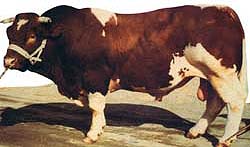
Cattle breeds: Maine Anjou
Origin
The Maine-Anjou breed originated in the Loire valley in France from the old English Durham breed, which was crossed with the local French Mancelle in the early 1800s, the type being fixed in the middle of the nineteenth century. Selection has been for both milk and meat production, as the Mancelle was a dairy breed.
Maine-Anjou semen was first imported into Australia in 1972, and has been followed by imports of purebred cattle and fertilised ova from New Zealand in recent years.
Distribution
At present there are only a few purebred Maine-Anjous in Australia, principally in Tasmania and New South Wales, although percentage stock is found in many parts of the country.
Breed characteristics

The Maine-Anjou is the largest of the French breeds. Although they are used for both meat and milk, they are best developed as beef producers. Their colouring is dark red and white, with the head always predominantly red and the eyes always surrounded by red colouring. They have medium-sized horns which curve forward like those of Shorthorns.
The breed is noted for its rapid growth and weight gain, is late maturing, and produces a high proportion of well-marbled muscle with a minimum of fat cover and a large rib-eye area. Like the Durham, the Maine-Anjou has proven ability in crossbreeding with British breeds, producing very acceptable crossbred calves.
Further information
For further information, contact the Maine-Anjou Society of Australia at:
Secretary: Lyn French
PO Box 2537
ORANGE NSW 2800
Phone: (02) 6365 5500
Fax: (02) 6365 5599
Email: frenchfamily1@bigpond.com.au
Website: www.maine-anjou.com.au
Acknowledgment
The author thanks the Australian Maine-Anjou Cattle Society Ltd for assistance in preparing this Agfact.

